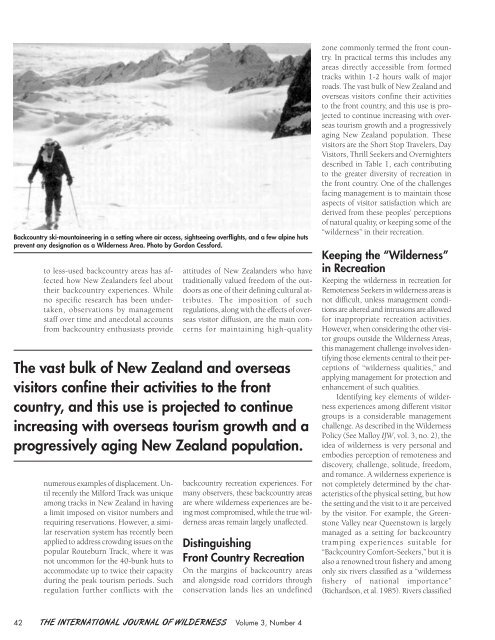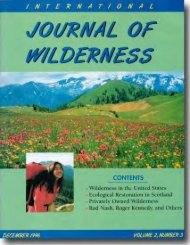Download full PDF - International Journal of Wilderness
Download full PDF - International Journal of Wilderness
Download full PDF - International Journal of Wilderness
Create successful ePaper yourself
Turn your PDF publications into a flip-book with our unique Google optimized e-Paper software.
Backcountry ski-mountaineering in a setting where air access, sightseeing overflights, and a few alpine huts<br />
prevent any designation as a <strong>Wilderness</strong> Area. Photo by Gordon Cessford.<br />
to less-used backcountry areas has affected<br />
how New Zealanders feel about<br />
their backcountry experiences. While<br />
no specific research has been undertaken,<br />
observations by management<br />
staff over time and anecdotal accounts<br />
from backcountry enthusiasts provide<br />
attitudes <strong>of</strong> New Zealanders who have<br />
traditionally valued freedom <strong>of</strong> the outdoors<br />
as one <strong>of</strong> their defining cultural attributes.<br />
The imposition <strong>of</strong> such<br />
regulations, along with the effects <strong>of</strong> overseas<br />
visitor diffusion, are the main concerns<br />
for maintaining high-quality<br />
The vast bulk <strong>of</strong> New Zealand and overseas<br />
visitors confine their activities to the front<br />
country, and this use is projected to continue<br />
increasing with overseas tourism growth and a<br />
progressively aging New Zealand population.<br />
numerous examples <strong>of</strong> displacement. Until<br />
recently the Milford Track was unique<br />
among tracks in New Zealand in having<br />
a limit imposed on visitor numbers and<br />
requiring reservations. However, a similar<br />
reservation system has recently been<br />
applied to address crowding issues on the<br />
popular Routeburn Track, where it was<br />
not uncommon for the 40-bunk huts to<br />
accommodate up to twice their capacity<br />
during the peak tourism periods. Such<br />
regulation further conflicts with the<br />
backcountry recreation experiences. For<br />
many observers, these backcountry areas<br />
are where wilderness experiences are being<br />
most compromised, while the true wilderness<br />
areas remain largely unaffected.<br />
Distinguishing<br />
Front Country Recreation<br />
On the margins <strong>of</strong> backcountry areas<br />
and alongside road corridors through<br />
conservation lands lies an undefined<br />
42 THE INTERNATIONAL JOURNAL OF WILDERNESS Volume 3, Number 4<br />
zone commonly termed the front country.<br />
In practical terms this includes any<br />
areas directly accessible from formed<br />
tracks within 1-2 hours walk <strong>of</strong> major<br />
roads. The vast bulk <strong>of</strong> New Zealand and<br />
overseas visitors confine their activities<br />
to the front country, and this use is projected<br />
to continue increasing with overseas<br />
tourism growth and a progressively<br />
aging New Zealand population. These<br />
visitors are the Short Stop Travelers, Day<br />
Visitors, Thrill Seekers and Overnighters<br />
described in Table 1, each contributing<br />
to the greater diversity <strong>of</strong> recreation in<br />
the front country. One <strong>of</strong> the challenges<br />
facing management is to maintain those<br />
aspects <strong>of</strong> visitor satisfaction which are<br />
derived from these peoples’ perceptions<br />
<strong>of</strong> natural quality, or keeping some <strong>of</strong> the<br />
“wilderness” in their recreation.<br />
Keeping the “<strong>Wilderness</strong>”<br />
in Recreation<br />
Keeping the wilderness in recreation for<br />
Remoteness Seekers in wilderness areas is<br />
not difficult, unless management conditions<br />
are altered and intrusions are allowed<br />
for inappropriate recreation activities.<br />
However, when considering the other visitor<br />
groups outside the <strong>Wilderness</strong> Areas,<br />
this management challenge involves identifying<br />
those elements central to their perceptions<br />
<strong>of</strong> “wilderness qualities,” and<br />
applying management for protection and<br />
enhancement <strong>of</strong> such qualities.<br />
Identifying key elements <strong>of</strong> wilderness<br />
experiences among different visitor<br />
groups is a considerable management<br />
challenge. As described in the <strong>Wilderness</strong><br />
Policy (See Malloy IJW, vol. 3, no. 2), the<br />
idea <strong>of</strong> wilderness is very personal and<br />
embodies perception <strong>of</strong> remoteness and<br />
discovery, challenge, solitude, freedom,<br />
and romance. A wilderness experience is<br />
not completely determined by the characteristics<br />
<strong>of</strong> the physical setting, but how<br />
the setting and the visit to it are perceived<br />
by the visitor. For example, the Greenstone<br />
Valley near Queenstown is largely<br />
managed as a setting for backcountry<br />
tramping experiences suitable for<br />
“Backcountry Comfort-Seekers,” but it is<br />
also a renowned trout fishery and among<br />
only six rivers classified as a “wilderness<br />
fishery <strong>of</strong> national importance”<br />
(Richardson, et al. 1985). Rivers classified










